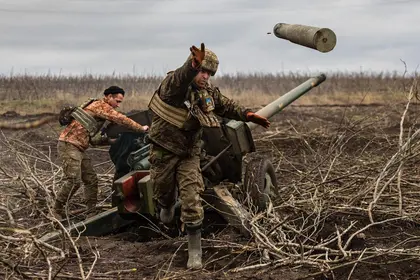As the one-year anniversary of Russia’s full-scale invasion of Ukraine approaches and renewed counteroffensives are expected in the coming weeks, the alarm is being raised over the supply of the crucial ammunition Kyiv needs to continue fighting.
"It is clear that we are in a race of logistics," NATO Secretary General Jens Stoltenberg said ahead of the meeting of the U.S.-led Ukraine Defense Contact Group in Brussels on Tuesday.
JOIN US ON TELEGRAM
Follow our coverage of the war on the @Kyivpost_official.
"Key capabilities like ammunition, fuel, and spare parts must reach Ukraine before Russia can seize the initiative on the battlefield.
“Speed will save lives.”
What does Ukraine need?
Aside from the well-covered subjects of new weapons like tanks, fighter jets and long-range missiles, Ukraine is also in need of the ammunition required to keep the weapons it already has firing – particularly 155-millimetre artillery shells.
Both sides are firing these shells by the thousands each day. It is not immediately clear how much munition exactly the Ukrainian Armed Forces (UAF) have spent over the past months but a French military source estimated that the Russians fired up to 50,000 artillery shells a day in the month of July, while the Ukrainians fired back some 6,000.
And the need for shells is only set to increase as fears grow that Moscow is gearing up for a fresh offensive in the coming weeks.

N. Korean Troops Massed in Russia to Enter Ukraine War ’Soon’: Pentagon Chief
Ukraine will likely need more munition than ever to defend itself.
Can Ukraine’s allies supply enough?
According to Stoltenberg, there is increasing concern over the issue.
"The war in Ukraine is consuming an enormous amount of munitions, and depleting allied stockpiles," he said on Monday.
"The current rate of Ukraine's ammunition expenditure is many times higher than our current rate of production. This puts our defense industries under strain."
Stoltenberg admitted that the Western military alliance was facing a "problem", as waiting times for large-caliber ammunition had grown from 12 to 28 months, AFP reports.
Why can’t countries just make more?
The production capabilities of factories and logistics chains in western countries simply aren’t set up to dealing with large-scale land war that very few people in the West saw coming after decades mostly fighting smaller-scale wars against poorly-armed insurgencies like in Afghanistan.
Take Stinger surface-to-air missiles and Javelin anti-tank missiles, for example. The U.S. has sent Kyiv 1,600 of the former and 8,500 of the latter.
That's the equivalent of 13 years of production for the Stingers, and five years of work for the Javelins, the head of U.S. defense firm Raytheon Technologies, Greg Hayes, warned in December.
Even partnering with fellow U.S. arms company Lockheed Martin to increase production, they could only produce 400 Javelin missiles per month. French arms industry firm Nexter Systems has an annual production capacity of several tens of thousands of 155-mm artillery shells, but a high-ranking member of the military said the group has "almost reached its limit.”
“Ultimately, the Western defense industry is not ready for war,” said William Alberque, an expert at the International Institute for Strategic Studies.
"Our defense industry -- ammunition, logistics, supplies, training -- is wholly inadequate to the task," he said, adding it was not ready for longer conflicts.
The West needed a better "defense industrial plan", he said, not just because of the war in Ukraine, but to be prepared for any escalations in other parts of the world, to be able to stand up to Russia, China, or even Iran and North Korea.
What’s being done to fix the problem?
NATO is scrambling to get its factories to pump out more, and allies are eyeing plans for joint weapons purchases, higher defense spending and longer-term contracts.
Estonian Prime Minister Kaja Kallas has called on EU states to acquire arms for Ukraine together, in the same way the bloc bought COVID-19 vaccines in bulk.
Can it be fixed?
Leo Peria-Peigne, a researcher at the French Institute of International Relations, said the West was slowly gearing up to restocking ammunition supplies.
But “it will depend on whether states are prepared to make the financial effort,” he said.
Ivan Klyszcz, a research fellow at the Estonia-based International Centre for Defense and Security, agreed the post-Cold War model was showing its “shortcomings.”
Within NATO, Poland, Romania and the Baltic states could possibly help produce ammunition for the Soviet equipment Ukraine still uses alongside the Western weapons, he said.
But he said contacts were also being made with nations outside the alliance like South Korea, Morocco, Jordan and Pakistan. “Short-term solutions will have to come from abroad,” Klyszcz said.
“Everything else will take months and months.”
You can also highlight the text and press Ctrl + Enter






